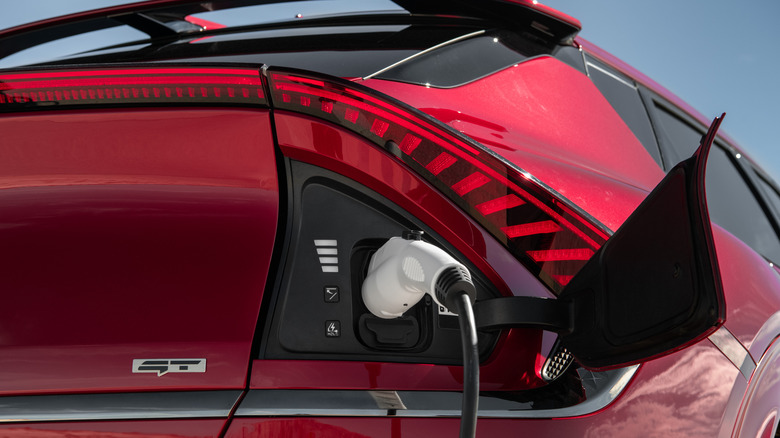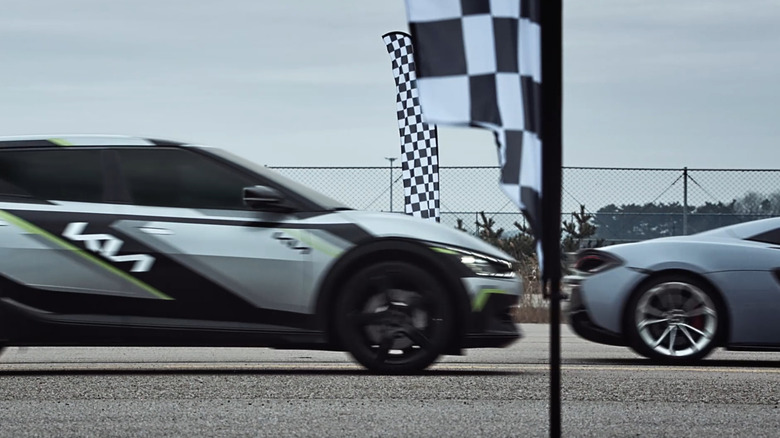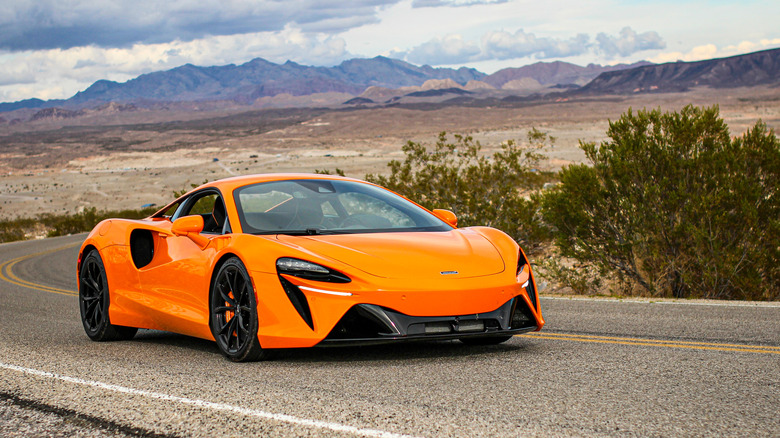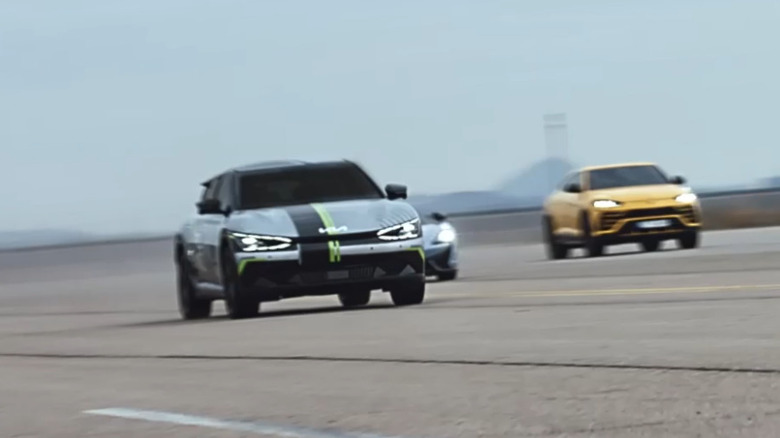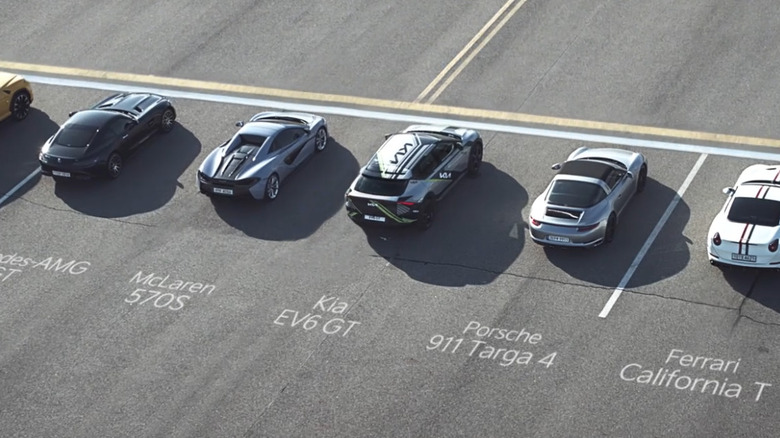How EVs Will Change The Performance Car World For The Better
The push to electrify cars is primarily focused on efficiency, but that doesn't mean EVs have to be boring. It's been a demonstrable fact that adding an electric motor to the mix results in big power delivery, in some manner or another. Hybrids supplement the combustion side of things, while full EVs skip the middle man completely and just let their motors do the talking. In a short time, we've seen automakers take different approaches to electrified performance, and some of the more recent examples couldn't be more different: the $61,400 BEV Kia EV6 GT and the $225,000 hybrid McLaren Artura.
We're going to compare apples to some very expensive oranges here but, as different as these cars are, they both have the same mission: provide sport performance powered in some fashion by electricity. Kia itself has been quite keen to remind everyone how its car can hang with — if not pull ahead of — the household names of premium performance.
Quick comparisons
The McLaren Artura is a rear-wheel drive two-seater coupe powered by a mid-mounted 3.0-liter twin-turbo V6 supported by an e-motor. It lays down a total of 671 horsepower and 530 pound-feet of torque. McLaren claims it can sprint from 0 to 60 in 3 seconds flat, and top out at 205 mph.
The Kia EV6 GT, meanwhile, is an all-wheel drive crossover that can seat four and has an ample amount of cargo room to spare. It's powered by two electric motors that can produce 576 horsepower and 546 pound-feet of torque. Its 0 to 60 time is 3.4 seconds, and it tops out at 161 mph.
While we're focusing on performance, it's worth mentioning the stated range of each car. Kia's EV6 GT has a total estimated range of 206 miles while the Artura has 340 miles worth of range. Obviously, how each are used affects these numbers greatly and they dictate just how much performance a driver can make use of within a session. The McLaren can party for longer and refuel quicker, but at a greater cost at the pump. The Kia won't be so pricy, but it will go through all of its juice quicker, and will take at least 18 minutes to charge at a top-tier charging station.
McLaren Artura
The McLaren Artura has a lot going for it, not the least of which is its handling. McLaren may be new to electrification, but its motorsport legacy is a long one, and so the Artura was built towards this strength. In terms of its hybrid system specifically, the electrics elevate more than dominate. The car's twin-turbo V6 does all the heavy lifting while the e-motor adds extra punch and smoothness when needed. While the car would be diminished if the battery ran dry, it wouldn't render the McLaren useless, and that's not to say the e-motor is a frivolous addition. Its extra 94 horsepower and torque go a long way to enhance the Artura's abilities. Plus, as it constantly recharges itself in the more aggressive drive modes, it's rare that the battery would dry up anyway. Because of this, it barely needs to be plugged in. For performance car fans gun-shy about electricity, it's the ideal combination of these two technologies.
Lastly, the e-motor delivers the Artura full EV driving for around 11 miles, which isn't a lot, but it does give the Artura an entire dimension of civility that other attention-grabbing supercars lack, and that's nice to have in-between track sessions.
From a certain point of view, however, the combustion-dominant powertrain will turn off the more evangelical EV fans. Sure, it's a hybrid, but the electric side of things is more for added flavor rather than a core ingredient. There's also the matter of the cost. Hybrid performance but for a premium price, and one that excludes it from a great deal of enthusiasts. Those who can afford it should also be prepared to dole out even more greenbacks for the maintenance costs supercars demand, and that's not mentioning any repair costs.
Kia EV6 GT
Kia's EV6 GT, on the other hand, comes in at $61,400. This is no pocket change, sure, but compared to the McLaren it's a relative steal, particularly if you factor in the comparable power output and acceleration speeds. This is EV power with no middle man: no combustion engine to cater to, no transmissions to manage things, it's all direct, dialed-in performance. Having no engine also makes it guilt-free fun, with the added benefit of no extra noise.
Kia has some sound effects built in to the EV6 GT, but those can be switched off, allowing drivers to concentrate on other sounds such as the squeal of tires that communicate their grip limits. There are also the inherent benefits of an EV platform available, such as a low center of gravity and the instantaneous torque delivery. These can make even the slower EVs fun to drive, so they're huge boons to quicker ones like the EV6 GT.
And while it is quick, the Kia isn't exactly a flawless performer. In this case, the electrification and efficiency came before the performance parts, so the EV6 GT's capabilities are due to enhanced components and tuning rather than part of the inherent design. While it might be quick enough to drag race other powerful and more expensive sports cars, beating these dedicated performance cars around a track is another matter altogether. If it tries, its limited range means it won't have more than a few shots to best them, either.
Charging forward
These are very different cars with their own positives and negatives — no pun intended — when it comes to how they handle electrified performance. What's important, though, is that they both show that EVs have a place at the sports car table, and that there is something there for a wide spectrum of enthusiasts. For the old-school, electrification in the form of a hybrid can elevate an already superb vehicle, particularly when its as unobtrusive as the system found in the McLaren Artura. For the full-on BEV adopters, vehicles like the Kia EV6 GT can provide enough performance to raise the eyebrows of the supercar elite, and do so at a far more affordable price. And this is just the start.
Many sports car manufacturers are making electric strides towards an EV performance future. Audi, for example, has been largely invested in this, preparing to have a full-electric lineup that already includes the RS e-tron GT and preparing to sunset its long-lived halo car, the R8, to make way for BEV follow-up. Similarly, Porsche's Taycan has been setting the benchmark for luxury EV performance.
Even Lamborghini has begun to make hesitant steps towards electrification. Its last V10-powered car, the Huracán, is taking its victory lap in the form of the Huracán Technica before that car and — the V10 chapter of Lamborghini's history — is closed, and its first series production hybrid hits the streets. Either way, from supercars to street-level performers, the move to electrification is shaping up to be a boon for enthusiasts, no matter what their flavor of sports cars may be.
